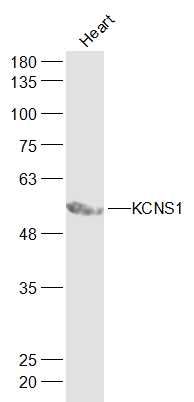KCNS1 Polyclonal Antibody
Purified Rabbit Polyclonal Antibody (Pab)
- 产品详情
- 实验流程
Application
| WB, IHC-P, IHC-F, IF, ICC |
|---|---|
| Primary Accession | Q96KK3 |
| Reactivity | Rat, Dog, Bovine |
| Host | Rabbit |
| Clonality | Polyclonal |
| Calculated MW | 58372 Da |
| Physical State | Liquid |
| Immunogen | KLH conjugated synthetic peptide derived from human KCNS1 |
| Epitope Specificity | 161-260/526 |
| Isotype | IgG |
| Purity | affinity purified by Protein A |
| Buffer | 0.01M TBS (pH7.4) with 1% BSA, 0.02% Proclin300 and 50% Glycerol. |
| SUBCELLULAR LOCATION | Cell membrane. May not reach the plasma membrane but remain in an intracellular compartment in the absence of KCNB1. |
| SIMILARITY | Belongs to the potassium channel family. S (TC 1.A.1.2) subfamily. Kv9.1/KCNS1 sub-subfamily. |
| Important Note | This product as supplied is intended for research use only, not for use in human, therapeutic or diagnostic applications. |
| Background Descriptions | Voltage-gated potassium channels form the largest and most diversified class of ion channels and are present in both excitable and nonexcitable cells. Their main functions are associated with the regulation of the resting membrane potential and the control of the shape and frequency of action potentials. The alpha subunits are of 2 types: those that are functional by themselves and those that are electrically silent but capable of modulating the activity of specific functional alpha subunits. The protein encoded by this gene is not functional by itself but can form heteromultimers with member 1 and with member 2 (and possibly other members) of the Shab-related subfamily of potassium voltage-gated channel proteins. This gene belongs to the S subfamily of the potassium channel family. [provided by RefSeq, Jul 2008] |
| Gene ID | 3787 |
|---|---|
| Other Names | Potassium voltage-gated channel subfamily S member 1, Delayed-rectifier K(+) channel alpha subunit 1, Voltage-gated potassium channel subunit Kv9.1, KCNS1 |
| Target/Specificity | Detected in all tissues tested with the exception of skeletal muscle. Highly expressed in adult and fetal brain, fetal kidney and lung, and adult prostate and testis. |
| Dilution | WB=1:500-2000,IHC-P=1:100-500,IHC-F=1:100-500,ICC=1:100-500,IF=1:100-500 |
| Format | 0.01M TBS(pH7.4) with 1% BSA, 0.09% (W/V) sodium azide and 50% Glyce |
| Storage | Store at -20 °C for one year. Avoid repeated freeze/thaw cycles. When reconstituted in sterile pH 7.4 0.01M PBS or diluent of antibody the antibody is stable for at least two weeks at 2-4 °C. |
| Name | KCNS1 (HGNC:6300) |
|---|---|
| Function | Potassium channel regulatory subunit that modulate the delayed rectifier voltage-gated potassium channel activity of KCNB1 and KCNB2 by altering their kinetics, expression levels, and shifting the half-inactivation potential to more polarized values (PubMed:10484328). While it does not form functional channels on its own, it can form functional heterotetrameric channels with KCNB1 and KCNB2 (PubMed:10484328). Each regulatory subunit has unique regulatory properties that can lead to extensive inhibition, significant changes in kinetics, and/or substantial shifts in the voltage dependencies of the inactivation process (By similarity). |
| Cellular Location | Cell membrane; Multi-pass membrane protein. Note=May not reach the plasma membrane but remain in an intracellular compartment in the absence of KCNB1 or KCNB2 (PubMed:10484328) |
| Tissue Location | Detected in all tissues tested with the exception of skeletal muscle (PubMed:10484328). Highly expressed in adult and fetal brain, fetal kidney and lung, and adult prostate and testis (PubMed:10484328). |
Research Areas
For Research Use Only. Not For Use In Diagnostic Procedures.
Application Protocols
Provided below are standard protocols that you may find useful for product applications.
终于等到您。ABCEPTA(百远生物)抗体产品。
点击下方“我要评价 ”按钮提交您的反馈信息,您的反馈和评价是我们最宝贵的财富之一,
我们将在1-3个工作日内处理您的反馈信息。
如有疑问,联系:0512-88856768 tech-china@abcepta.com.
¥ 1,500.00
Cat# AP56466























 癌症的基本特征包括细胞增殖、血管生成、迁移、凋亡逃避机制和细胞永生等。找到癌症发生过程中这些通路的关键标记物和对应的抗体用于检测至关重要。
癌症的基本特征包括细胞增殖、血管生成、迁移、凋亡逃避机制和细胞永生等。找到癌症发生过程中这些通路的关键标记物和对应的抗体用于检测至关重要。 为您推荐一个泛素化位点预测神器——泛素化分析工具,可以为您的蛋白的泛素化位点作出预测和评分。
为您推荐一个泛素化位点预测神器——泛素化分析工具,可以为您的蛋白的泛素化位点作出预测和评分。 细胞自噬受体图形绘图工具为你的蛋白的细胞受体结合位点作出预测和评分,识别结合到自噬通路中的蛋白是非常重要的,便于让我们理解自噬在正常生理、病理过程中的作用,如发育、细胞分化、神经退化性疾病、压力条件下、感染和癌症。
细胞自噬受体图形绘图工具为你的蛋白的细胞受体结合位点作出预测和评分,识别结合到自噬通路中的蛋白是非常重要的,便于让我们理解自噬在正常生理、病理过程中的作用,如发育、细胞分化、神经退化性疾病、压力条件下、感染和癌症。






